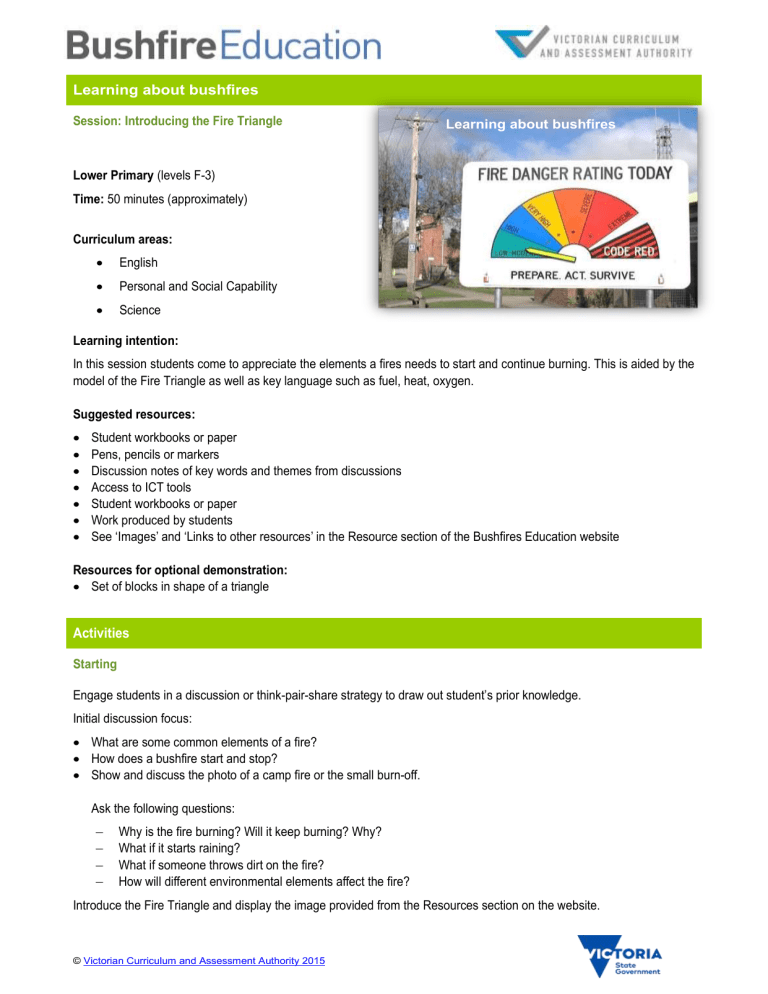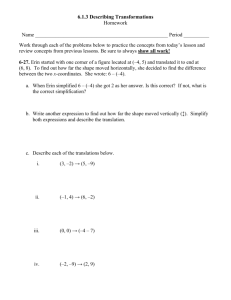The Fire Triangle.

Learning about bushfires
Session: Introducing the Fire Triangle
Learning about bushfires
Lower Primary (levels F-3)
Time: 50 minutes (approximately)
Curriculum areas:
English
Personal and Social Capability
Science
Learning intention:
In this session students come to appreciate the elements a fires needs to start and continue burning. This is aided by the model of the Fire Triangle as well as key language such as fuel, heat, oxygen.
Suggested resources:
Student workbooks or paper
Pens, pencils or markers
Discussion notes of key words and themes from discussions
Access to ICT tools
Student workbooks or paper
Work produced by students
See ‘Images’ and ‘Links to other resources’ in the Resource section of the Bushfires Education website
Resources for optional demonstration:
Set of blocks in shape of a triangle
Activities
Starting
Engage students in a discussion or think-pair-share strategy to draw out student’s prior knowledge.
Initial discussion focus:
What are some common elements of a fire?
How does a bushfire start and stop?
Show and discuss the photo of a camp fire or the small burn-off.
Ask the following questions:
Why is the fire burning? Will it keep burning? Why?
What if it starts raining?
What if someone throws dirt on the fire?
How will different environmental elements affect the fire?
Introduce the Fire Triangle and display the image provided from the Resources section on the website.
© Victorian Curriculum and Assessment Authority 2015
It has three essential components(background information provided for the educator):
1.
Fuel - Fuel is any kind of combustible material, and is characterized by its moisture content (how wet the fuel is), size and shape, quantity, and the arrangement in which it is spread over the landscape. The moisture content determines how easily that fuel will burn.
2.
Heat - A heat source is responsible for the initial ignition of fire, and heat is also needed to maintain the fire and permit it to spread. Heat allows fire to spread by removing the moisture from nearby fuel, warming surrounding air, and preheating the fuel in its path, enabling it to travel with greater ease.
3.
Oxygen in the air - Air contains about 21% oxygen, and most fires require at least 16% oxygen content to burn. Oxygen supports the chemical processes that occur during a wildland fire. When fuel burns, it reacts with oxygen from the surrounding air releasing heat and generating combustion products (i.e. gases, smoke,embers). This process is known as oxidation.
Review the characteristics of each key word.
This model demonstrates if one element is missing, the fire will go out.
Guide the discussion towards:
Who or what keeps a fire safe?
Key ideas:
Making sure that a fire is always attended by an adult
Clearing an area by at least 3 metres
Having plenty of water nearby.
Why are these actions important to safety and preventing bushfires?
Refer back to and view again the camp fire and burn-off images to assist in making links to these good fires to the Fire
Triangle.
Exploring
Introduce terms: heat, flame, smoke, wind.
Assist students' to develop definitions of these terms.
Ask students to think about how these elements relate to the Fire Triangle.
Are other elements that could also affect the Fire Triangle?
Why is knowing about the Fire Triangle important (e.g. being able to make a campfire or start a barbeque)
Remind students about helpful fires such as barbecues and camp fires.
What is the effect of sparks and embers (small pieces of burning leaves, twigs and bark) being blown by the wind away from the fire?
Make Explicit:
Everyone has a responsibility to help prevent bushfires by being careful with fires in the outdoors, and that information about the danger of fire helps everyone stay safe (i.e. knowing how how to prevent them).
© VCAA 2015 Page 2
Optional demonstration:
The teacher to conduct a demonstration to show each of the three aspects of the Fire Triangle.
Students can record on a chart 'Predictions', 'What happened' and 'Explanation'.
Teacher to demonstrate:
Take away the bock with air on it. Why did the pretend fire go out? (We removed the air.)
Take away the block with heat on it. Why did the pretend fire go out? (We cooled the fuel down.)
Take away the block with fuel on it. Why did the pretend fire go out? (We cut off the fuel supply.)
Discuss how the Fire Triangle can help us understand bushfires.
Bringing it together
Students' messages and signs:
Provide an opportunity for students to create, discuss and display their own messages and signs about the Fire Triangle.
This may be done as voice recording, on posters, in work books, as a sign or using appropriate ICT programs such as generating a slide show.
Extending
Presenting Students' messages and signs:
Provide an audience for students to formally plan and then present their message about the elements of the Fire
Triangle.
© VCAA 2015 Page 3






